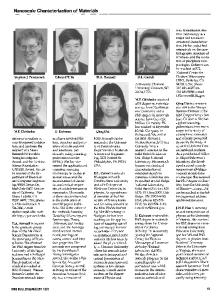Electrical Characterization of Nanoscale Ferroelectric Structures
The present chapter focuses on the electrical characterization of small ferroelectric capacitors and the problems arising from going to smaller and smaller structure sizes. In particular, the electrical hysteresis loop is investigated as a key property of
- PDF / 3,081,613 Bytes
- 28 Pages / 439.37 x 666.142 pts Page_size
- 101 Downloads / 330 Views
3.1 Introduction The present chapter focuses on the electrical characterization of small ferroelectric capacitors and the problems arising from going to smaller and smaller structure sizes. In particular, the electrical hysteresis loop is investigated as a key property of ferroelectric materials. The use of direct electrical measurements on nanoscale ferroelectric materials can be found applications on the one hand, such as ferroelectric memories or probe storage devices [1]. Here it is necessary for example to record the switching charge during the read operation or to investigate the failure mechanisms of the material after a complete integration process. Averaged results on an array of capacitors are not sufficient to analyse single bit failures [1,2]. Based on the proved resolution of the analog results on sub micrometer capacitors, which are of the same size as single memory cell capacitors, a test concept of memory devices has been developed [3]. These results help to reduce the time to market of the product, as they give feedback for rapid process optimization. On the other hand for scientific research and understanding materials the direct electrical measurements of the electrical properties give information additional to the results of mechanical measurements. For example, single grains can be investigated with respect to their electrical properties and a correlation of the domain distribution with the electrical results might be found. Furthermore, electrical measurements are limited in resolution to a minimum area, but mainly independent of the thickness of the sample. Piezoresponse measurements, which are normally used to determine the size limit for ferroelectric behavior [4], require a minimum thickness in order to detect the mechanical response of the material after electrical excitation. So, both methods can be used to investigate this limit; as in the electrical measurements, several structures can be connected in parallel. From the results of the piezoresponse measurement it is not possible to calculate the electrical hysteresis or the small capacitance versus voltage charateristic of the same sample. This calculation is possible only for single-domain, single-crystal ferroelectrics [5].
M. Alexe et al. (eds.), Nanoscale Characterisation of Ferroelectric Materials © Springer-Verlag Berlin Heidelberg 2004
88
S.Tiedke and T. Schmitz
3.2 P(V) Curve and Characteristic Values To obtain the electrical hysteresis loop of a ferroelectric sample a voltage is applied to the material and the displacement charge response during the voltage sweep is recorded. Plotting the charge normalized to the area of the material sample versus the voltage results in the P(V) curve, which is called the hysteresis loop. The intercept points on the polarization and voltage axis give characteristic values of the material and allow a classification of materials similar to that for magnetic materials. A material offering a small area of the ferroelectric hysteresis corresponds to small energy losses in the material during a
Data Loading...










